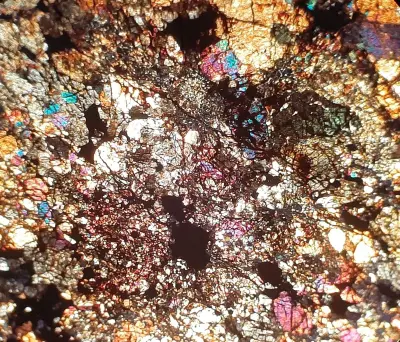Usually, these stones are not much different from the stones found on the earth, but when meteorites fall on the earth, they pass through the earth's atmosphere at a high speed, and their entry into the earth's atmosphere causes them to burn and a crust called "burnt crust" forms on the stone

A Meteorite is a solid object that originates from outer space and survives its passage through the Earth's atmosphere to reach the Earth's surface. It is a fragment of a meteoroid, which is a smaller object in space, typically composed of Rock or metal, that orbits the Sun. When a meteoroid enters the Earth's atmosphere, it undergoes intense heating and friction, causing it to burn up and create a bright streak of light, known as a meteor or a shooting star. If a meteoroid is large enough and can withstand the atmospheric forces, it may reach the Earth's surface as a meteorite. Meteorites can vary in size, ranging from tiny fragments to larger objects weighing several tons. They can be composed of various materials, including rock, metal, or a combination of both.
Meteorite enthusiasts and scientists often engage in meteorite hunting. They search for meteorites in areas where falls or finds have occurred, such as deserts or regions with less vegetation. Advanced Metal detectors, visual observations, and magnetic surveys are among the methods used to locate meteorites. A meteorite is a fragment of a space body that falls to the surface of our planet after passing through the Earth's atmosphere. The term also applies broadly to similar objects that fall on the surface of other planets and other large celestial bodies. These bodies are space Rocks that were torn from the surface of other bodies and fell on Earth, and we call these rocks "meteorites" or "sky stones". Meteorites contain amounts of metallic elements such as pure iron, and studying these heavenly Stones is one of the most important methods of obtaining information regarding the formation of the solar system, such as planets, moons, and other smaller objects.
Meteorites are classified as either "falls" or "finds." Meteorite falls are witnessed events in which people observe the meteorite entering the Earth's atmosphere and landing. Meteorite finds, on the other hand, are objects discovered on the ground, and their origin is often unknown. Some meteorite finds may have been on Earth for thousands or even millions of years before being discovered. Usually, these stones are not much different from the stones found on the earth, but when meteorites fall on the earth, they pass through the earth's atmosphere at a high speed, and their entry into the earth's atmosphere causes them to burn and a crust called "burnt crust" forms on the stone. is formed and this is one of the main characteristics of meteorites. Identifying meteorites is an easy task for scientists. They can distinguish meteorites from other stones by several methods. There are three types of meteorites: stony, iron and stony-iron. Each of these has specific characteristics.
Meteorites are of great scientific importance. They provide valuable information about the early solar system, planetary formation, and the geology of other celestial bodies. Scientists study meteorites to understand the processes that led to the formation and evolution of planets, asteroids, and other objects in our solar system. They can also shed light on the origin of water and organic compounds on Earth. An asteroid is a small rocky body that orbits the Sun. A meteorite is a small fragment of an asteroid or a comet that enters the Earth's atmosphere while burning up. When meteorites enter the atmosphere of the earth or another planet like Mars at a high speed and burn up, they are called meteors, which we also call comets. Sometimes meteors can even appear brighter than Venus, which is when we call them fireballs. Scientists estimate that about 48.5 tons (44,000 kg) of meteorite material falls on Earth every day.
The impact of a meteorite can vary widely depending on its size, speed, and composition. Smaller meteorites often create small craters or holes upon impact, while larger ones can cause significant damage and create larger impact craters. Meteorites can have diverse compositions. Stony meteorites are primarily composed of silicate Minerals such as olivine, pyroxene, and feldspar. Iron meteorites consist mostly of iron-nickel alloy, with traces of other elements like cobalt and phosphorus. Stony-iron meteorites contain a mix of silicate minerals and metal. When a meteorite lands on Earth, it is often accompanied by a loud sound, known as a sonic boom, and can create a small crater upon impact. Scientists study meteorites because they provide valuable information about the composition and history of the solar system. They can contain clues about the formation and evolution of planets, asteroids, and other celestial bodies.



